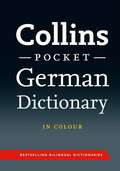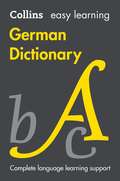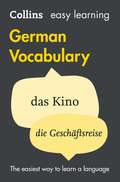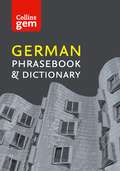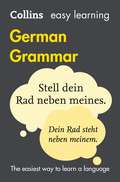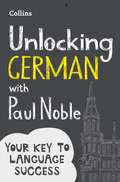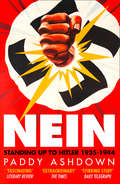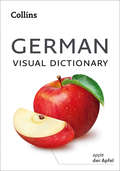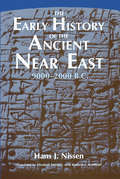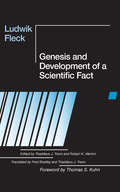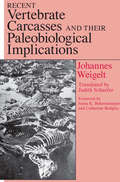- Table View
- List View
Collins Pocket German Dictionary (Collins Pocket) (PDF)
by CollinsFeatures include: All the latest words in both languages, such as antivirus, carbon footprint in English, and herunterladbar, Kamerahandy in German Full GCSE coverage An in-depth and up-to-date supplement with information about Germany, its people and its language to help you take your learning to the next level Help with German verbs Clear, colour layout, useful examples, language and cultural notes COLLINS POCKET GERMAN DICTIONARYhas been designed to give travellers, business people and the general user alike all the information they need in a portable, hard-wearing format. It includes all the latest words reflecting changes in modern lifestyle, as well as all the features you would expect from a Collins dictionary: an easy-to-read colour layout, special treatment of key words such as can, that, gut, lassen, notes about life in German-speaking countries and warnings on commonly confused words. An in-depth and up-to-date supplement helps you to develop your knowledge of German and your confidence in the language, with a section on common translation difficulties to guide you. There is information on pronunciation and improving your fluency, as well as the words and phrases you will need in different situations, like sending email or making a phone call. The supplement also gives you an insight into Germany, its people and other German-speaking countries. Verb tables show all verb forms for the most common German verbs and give examples of how these are used. Also available in the Collins German dictionary range are Collins German School Dictionary, Collins Easy Learning German Dictionary, Collins German Dictionary & Grammar and Collins German Phrasebooks for mobile phone and iPod
Collins Easy Learning German - Easy Learning German Dictionary
by Harpercollins PublishersCollins Easy Learning German Dictionary is an up-to-date, easy-reference dictionary with key GCSE curriculum words highlighted and a practical and fun supplement covering key vocabulary areas. It is the ideal dictionary for learners of German of all ages, but especially for those aiming for GCSE exam success. The bestselling Collins Easy Learning German Dictionary is designed for all learners of German, whether you are learning for your GCSE exams at school, in an evening class, for business or to go on holiday. The entries cover everyday German and English (including all essential set expressions) and key curriculum words are highlighted to help with exam preparation. It is also fully endorsed by the exam board, Edexcel. Clear and concise language notes provide information on common grammatical errors and confusable words, while handy culture notes explain cultural differences. German verbs are cross-referred to comprehensive verb tables, helping you find all the German verb forms you need. Combined with a text which is colour-coded and very easy to navigate, the Collins Easy Learning German Dictionary gives a solid foundation for German language learning. Get it right: thousands of examples of real German show you exactly how translations are used. Get there fast: clear colour layout takes you quickly to the words you want, with key GCSE vocabulary flagged for rapid identification. Have confidence: a fun, practical supplement focuses on key exam vocabulary and helps you to use written and spoken German correctly. Log onto www. collinslanguage. com/easyresources to access a wealth of free downloadable resources to help you practise and consolidate your language skills. Other titles available in the Collins Easy Learning German range are: Collins Easy Learning German Grammar, Collins Easy Learning German Verbs and Collins Easy Learning German Words.
Collins Easy Learning German - Easy Learning German Dictionary
by Ace CollinsCollins Easy Learning German Dictionary is an up-to-date, easy-reference dictionary with key GCSE curriculum words highlighted and a practical and fun supplement covering key vocabulary areas. It is the ideal dictionary for learners of German of all ages, but especially for those aiming for GCSE exam success. The bestselling Collins Easy Learning German Dictionary is designed for all learners of German, whether you are learning for your GCSE exams at school, in an evening class, for business or to go on holiday. The entries cover everyday German and English (including all essential set expressions) and key curriculum words are highlighted to help with exam preparation. It is also fully endorsed by the exam board, Edexcel. Clear and concise language notes provide information on common grammatical errors and confusable words, while handy culture notes explain cultural differences. German verbs are cross-referred to comprehensive verb tables, helping you find all the German verb forms you need. Combined with a text which is colour-coded and very easy to navigate, the Collins Easy Learning German Dictionary gives a solid foundation for German language learning. Get it right: thousands of examples of real German show you exactly how translations are used. Get there fast: clear colour layout takes you quickly to the words you want, with key GCSE vocabulary flagged for rapid identification. Have confidence: a fun, practical supplement focuses on key exam vocabulary and helps you to use written and spoken German correctly. Log onto www. collinslanguage. com/easyresources to access a wealth of free downloadable resources to help you practise and consolidate your language skills. Other titles available in the Collins Easy Learning German range are: Collins Easy Learning German Grammar, Collins Easy Learning German Verbs and Collins Easy Learning German Words.
Easy Learning German Vocabulary
by Collins DictionariesThe quickest way to study the essential German words and the perfect companion to titles in the ever-popular Easy Learning German range.
Collins German Phrasebook and Dictionary Gem Edition: Phrasebook And Dictionary (Collins Gem #04)
by Collins DictionariesYou will never be lost for words in your travels around Germany and German-speaking countries again! Your ideal travel companion will ensure that you can say what you need in German with ease and confidence.
Easy Learning German Complete Grammar, Verbs and Vocabulary (3 books in 1)
by Collins DictionariesA handy 3-in-1 German study book: grammar, verbs and vocabulary in one volume, ideal for beginners who need a clear and easy-to-understand German reference and revision guide.
Easy Learning German Grammar (Collins Easy Learning Ser.)
by Collins DictionariesWith all the new German spellings, this book offers beginners a clear and easy-to-understand guide to the verbs and grammar of German. Ideal for German revision.
Easy Learning German Verbs (Collins Easy Learning Ser.)
by Collins DictionariesPerfect for German revision offering beginners a clear and easy-to-understand guide to German verbs.
Unlocking German with Paul Noble: Your Key To Language Success
by Paul NobleEver tried to learn German and found it too hard? Bestselling language coach Paul Noble has a quick and easy way to get you back on track with his unique tried-and-tested method.
Nein!: Standing Up To Hitler 1935-1944
by Paddy AshdownFrom the bestselling and prize-winning author Paddy Ashdown, a revelatory new history of German opposition to Hitler from 1935 – 1944
Collins German Visual Dictionary (Collins Visual Dictionaries Ser.)
by Collins DictionariesA photographic guide to the key words and phrases in German. This attractive ebook is a perfect travel companion and provides a practical guide to Germany and German language and culture.
The Early History of the Ancient Near East, 9000-2000 B.C.
by Hans J. NissenHans J. Nissen here provides a much-needed overview of 7000 years of development in the ancient Near East from the beginning of settled life to the formation of the first regional states. His approach to the study of Mesopotamian civilization differs markedly from conventional orientations, which impose a sharp division between prehistoric and historic, literate, periods. Nissen argues that this approach is too rigid to explain the actual development of that civilization. He deemphasizes the invention of writing as a turning point, viewing it as simply one more phase in the evolution of social complexity and as the result of specific social, economic, and political factors. With a unique combination of material culture analysis written data, Nissan traces the emergence of the earliest isolated settlements, the growth of a network of towns, the emergence of city states, and finally the appearance of territorial states. From his synthesis of the prehistoric and literate periods comes a unified picture of the development of Mesopotamian economy, society, and culture. Lavishly illustrated, The Early History of the Ancient Near East, 9000-2000 B.C. is an authoritative work by one of the most insightful observers of the evolution and character of Mesopotamian civilization.
The Early History of the Ancient Near East, 9000-2000 B.C.
by Hans J. NissenHans J. Nissen here provides a much-needed overview of 7000 years of development in the ancient Near East from the beginning of settled life to the formation of the first regional states. His approach to the study of Mesopotamian civilization differs markedly from conventional orientations, which impose a sharp division between prehistoric and historic, literate, periods. Nissen argues that this approach is too rigid to explain the actual development of that civilization. He deemphasizes the invention of writing as a turning point, viewing it as simply one more phase in the evolution of social complexity and as the result of specific social, economic, and political factors. With a unique combination of material culture analysis written data, Nissan traces the emergence of the earliest isolated settlements, the growth of a network of towns, the emergence of city states, and finally the appearance of territorial states. From his synthesis of the prehistoric and literate periods comes a unified picture of the development of Mesopotamian economy, society, and culture. Lavishly illustrated, The Early History of the Ancient Near East, 9000-2000 B.C. is an authoritative work by one of the most insightful observers of the evolution and character of Mesopotamian civilization.
The Early History of the Ancient Near East, 9000-2000 B.C.
by Hans J. NissenHans J. Nissen here provides a much-needed overview of 7000 years of development in the ancient Near East from the beginning of settled life to the formation of the first regional states. His approach to the study of Mesopotamian civilization differs markedly from conventional orientations, which impose a sharp division between prehistoric and historic, literate, periods. Nissen argues that this approach is too rigid to explain the actual development of that civilization. He deemphasizes the invention of writing as a turning point, viewing it as simply one more phase in the evolution of social complexity and as the result of specific social, economic, and political factors. With a unique combination of material culture analysis written data, Nissan traces the emergence of the earliest isolated settlements, the growth of a network of towns, the emergence of city states, and finally the appearance of territorial states. From his synthesis of the prehistoric and literate periods comes a unified picture of the development of Mesopotamian economy, society, and culture. Lavishly illustrated, The Early History of the Ancient Near East, 9000-2000 B.C. is an authoritative work by one of the most insightful observers of the evolution and character of Mesopotamian civilization.
The Early History of the Ancient Near East, 9000-2000 B.C.
by Hans J. NissenHans J. Nissen here provides a much-needed overview of 7000 years of development in the ancient Near East from the beginning of settled life to the formation of the first regional states. His approach to the study of Mesopotamian civilization differs markedly from conventional orientations, which impose a sharp division between prehistoric and historic, literate, periods. Nissen argues that this approach is too rigid to explain the actual development of that civilization. He deemphasizes the invention of writing as a turning point, viewing it as simply one more phase in the evolution of social complexity and as the result of specific social, economic, and political factors. With a unique combination of material culture analysis written data, Nissan traces the emergence of the earliest isolated settlements, the growth of a network of towns, the emergence of city states, and finally the appearance of territorial states. From his synthesis of the prehistoric and literate periods comes a unified picture of the development of Mesopotamian economy, society, and culture. Lavishly illustrated, The Early History of the Ancient Near East, 9000-2000 B.C. is an authoritative work by one of the most insightful observers of the evolution and character of Mesopotamian civilization.
Genesis and Development of a Scientific Fact
by Ludwik FleckOriginally published in German in 1935, this monograph anticipated solutions to problems of scientific progress, the truth of scientific fact and the role of error in science now associated with the work of Thomas Kuhn and others. Arguing that every scientific concept and theory—including his own—is culturally conditioned, Fleck was appreciably ahead of his time. And as Kuhn observes in his foreword, "Though much has occurred since its publication, it remains a brilliant and largely unexploited resource." "To many scientists just as to many historians and philosophers of science facts are things that simply are the case: they are discovered through properly passive observation of natural reality. To such views Fleck replies that facts are invented, not discovered. Moreover, the appearance of scientific facts as discovered things is itself a social construction, a made thing. A work of transparent brilliance, one of the most significant contributions toward a thoroughly sociological account of scientific knowledge."—Steven Shapin, Science
Genesis and Development of a Scientific Fact
by Ludwik FleckOriginally published in German in 1935, this monograph anticipated solutions to problems of scientific progress, the truth of scientific fact and the role of error in science now associated with the work of Thomas Kuhn and others. Arguing that every scientific concept and theory—including his own—is culturally conditioned, Fleck was appreciably ahead of his time. And as Kuhn observes in his foreword, "Though much has occurred since its publication, it remains a brilliant and largely unexploited resource." "To many scientists just as to many historians and philosophers of science facts are things that simply are the case: they are discovered through properly passive observation of natural reality. To such views Fleck replies that facts are invented, not discovered. Moreover, the appearance of scientific facts as discovered things is itself a social construction, a made thing. A work of transparent brilliance, one of the most significant contributions toward a thoroughly sociological account of scientific knowledge."—Steven Shapin, Science
Genesis and Development of a Scientific Fact
by Ludwik FleckOriginally published in German in 1935, this monograph anticipated solutions to problems of scientific progress, the truth of scientific fact and the role of error in science now associated with the work of Thomas Kuhn and others. Arguing that every scientific concept and theory—including his own—is culturally conditioned, Fleck was appreciably ahead of his time. And as Kuhn observes in his foreword, "Though much has occurred since its publication, it remains a brilliant and largely unexploited resource." "To many scientists just as to many historians and philosophers of science facts are things that simply are the case: they are discovered through properly passive observation of natural reality. To such views Fleck replies that facts are invented, not discovered. Moreover, the appearance of scientific facts as discovered things is itself a social construction, a made thing. A work of transparent brilliance, one of the most significant contributions toward a thoroughly sociological account of scientific knowledge."—Steven Shapin, Science
Genesis and Development of a Scientific Fact
by Ludwik FleckOriginally published in German in 1935, this monograph anticipated solutions to problems of scientific progress, the truth of scientific fact and the role of error in science now associated with the work of Thomas Kuhn and others. Arguing that every scientific concept and theory—including his own—is culturally conditioned, Fleck was appreciably ahead of his time. And as Kuhn observes in his foreword, "Though much has occurred since its publication, it remains a brilliant and largely unexploited resource." "To many scientists just as to many historians and philosophers of science facts are things that simply are the case: they are discovered through properly passive observation of natural reality. To such views Fleck replies that facts are invented, not discovered. Moreover, the appearance of scientific facts as discovered things is itself a social construction, a made thing. A work of transparent brilliance, one of the most significant contributions toward a thoroughly sociological account of scientific knowledge."—Steven Shapin, Science
Recent Vertebrate Carcasses and Their Paleobiological Implications
by Johannes WeigeltThe first English translation of Johannes Weigelt's 1927 classic makes available the seminal work in taphonomy, the study of how organisms die, decay, become entombed in sediments, and fossilize over time. Weigelt emphasized the importance of empirical work and made extensive observations of modern carcasses on the Texas Gulf Coast. He applied the results to evidence from the fossil record and demonstrated that an understanding of the postmortem fate of modern animals is crucial to making sound inferences about fossil vertebrate assemblages and their ecological communities. Weigelt spent sixteen months on the Gulf Coast in the mid-1920s, gathering evidence from the carcasses of cattle and other animals in the early stages of preservation. This book reports his observations. He discusses death and decomposition; classifies various modes of death (drowning, cold, dehydration, fire, mud, quicksand, oil slicks, etc.); documents and analyzes the positions of carcasses; presents detailed data on carcass assemblages at the Smither's Lake site in Texas; and, in a final chapter, makes comparisons to carcass assemblages from the geologic past. He raises questions about whether much of the fossil record is a product of unusual events and, if so, what the implications are for paleoecological studies. The English edition of Recent Vertebrate Carcasses includes a foreword and a translator's note that comment on Weigelt's life and the significance of his work. The original bibliography has been brought up to date, and, where necessary, updated scientific and place names have been added to the text in brackets. An index of names, places, and subjects is included, and Weigelt's own photographs of carcasses and drawings of skeletons illustrate the text.
Recent Vertebrate Carcasses and Their Paleobiological Implications
by Johannes WeigeltThe first English translation of Johannes Weigelt's 1927 classic makes available the seminal work in taphonomy, the study of how organisms die, decay, become entombed in sediments, and fossilize over time. Weigelt emphasized the importance of empirical work and made extensive observations of modern carcasses on the Texas Gulf Coast. He applied the results to evidence from the fossil record and demonstrated that an understanding of the postmortem fate of modern animals is crucial to making sound inferences about fossil vertebrate assemblages and their ecological communities. Weigelt spent sixteen months on the Gulf Coast in the mid-1920s, gathering evidence from the carcasses of cattle and other animals in the early stages of preservation. This book reports his observations. He discusses death and decomposition; classifies various modes of death (drowning, cold, dehydration, fire, mud, quicksand, oil slicks, etc.); documents and analyzes the positions of carcasses; presents detailed data on carcass assemblages at the Smither's Lake site in Texas; and, in a final chapter, makes comparisons to carcass assemblages from the geologic past. He raises questions about whether much of the fossil record is a product of unusual events and, if so, what the implications are for paleoecological studies. The English edition of Recent Vertebrate Carcasses includes a foreword and a translator's note that comment on Weigelt's life and the significance of his work. The original bibliography has been brought up to date, and, where necessary, updated scientific and place names have been added to the text in brackets. An index of names, places, and subjects is included, and Weigelt's own photographs of carcasses and drawings of skeletons illustrate the text.
Recent Vertebrate Carcasses and Their Paleobiological Implications
by Johannes WeigeltThe first English translation of Johannes Weigelt's 1927 classic makes available the seminal work in taphonomy, the study of how organisms die, decay, become entombed in sediments, and fossilize over time. Weigelt emphasized the importance of empirical work and made extensive observations of modern carcasses on the Texas Gulf Coast. He applied the results to evidence from the fossil record and demonstrated that an understanding of the postmortem fate of modern animals is crucial to making sound inferences about fossil vertebrate assemblages and their ecological communities. Weigelt spent sixteen months on the Gulf Coast in the mid-1920s, gathering evidence from the carcasses of cattle and other animals in the early stages of preservation. This book reports his observations. He discusses death and decomposition; classifies various modes of death (drowning, cold, dehydration, fire, mud, quicksand, oil slicks, etc.); documents and analyzes the positions of carcasses; presents detailed data on carcass assemblages at the Smither's Lake site in Texas; and, in a final chapter, makes comparisons to carcass assemblages from the geologic past. He raises questions about whether much of the fossil record is a product of unusual events and, if so, what the implications are for paleoecological studies. The English edition of Recent Vertebrate Carcasses includes a foreword and a translator's note that comment on Weigelt's life and the significance of his work. The original bibliography has been brought up to date, and, where necessary, updated scientific and place names have been added to the text in brackets. An index of names, places, and subjects is included, and Weigelt's own photographs of carcasses and drawings of skeletons illustrate the text.
Georg Simmel on Individuality and Social Forms (Heritage of Sociology Series)
by Georg Simmel"Of those who created the intellectual capital used to launch the enterprise of professional sociology, Georg Simmel was perhaps the most original and fecund. In search of a subject matter for sociology that would distinguish it from all other social sciences and humanistic disciplines, he charted a new field for discovery and proceeded to explore a world of novel topics in works that have guided and anticipated the thinking of generations of sociologists. Such distinctive concepts of contemporary sociology as social distance, marginality, urbanism as a way of life, role-playing, social behavior as exchange, conflict as an integrating process, dyadic encounter, circular interaction, reference groups as perspectives, and sociological ambivalence embody ideas which Simmel adumbrated more than six decades ago."—Donald N. Levine Half of the material included in this edition of Simmel's writings represents new translations. This includes Simmel's important, lengthy, and previously untranslated "Group Expansion and Development of Individuality," as well as three selections from his most neglected work, Philosophy of Money; in addition, the introduction to Probleme der Geschichtsphilosophie, chapter one of the Lebensanschauung, and three essays are translated for the first time.

